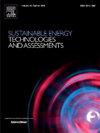Hydrogen storage-learning from nature: The air clathrate hydrate in polar ice sheets
IF 7.1
2区 工程技术
Q1 ENERGY & FUELS
Sustainable Energy Technologies and Assessments
Pub Date : 2024-10-25
DOI:10.1016/j.seta.2024.104007
引用次数: 0
Abstract
Hydrogen storage poses a major challenge to mobile, stationary, and portable energy in better serving a low-carbon economy and sustainable future of humankind. Existing hydrogen storage methods are typical of low storage capacity, complicated storage technology, high capital cost, great storage risk, and excess carbon emissions. Here, the hydrogen clathrate hydrate in powdered-ice Ih (HCHinIh) is empirically synthesized at relatively lower pressures from ∼6.3–12.9 MPa and relatively higher temperatures from ∼243–273 K for innovative hydrogen storage, building on lessons from the enclathration of the air clathrate hydrates that naturally formed in polar ice sheets. As a result, the enclathration for HCHinIh is forced by the dynamical evolution of bubbles under the quasi-densification of powdered-ice Ih. In addition, the estimated hydrogen storage capacity of 3.44 wt% for the HCHinIh is comparable to, or even far higher than those from the existential hydrogen storage technologies, and the potential to be improved by upgrading the designed synthesis apparatus for the HCHinIh. Thus, this work paves a novel route by mimicking Nature to advance hydrogen storage via synthesizing the HCHinIh in achieving higher storage capacity, simpler storage technology, lower capital cost, less storage risk, as well as net zero-carbon emissions.
氢储存--向大自然学习:极地冰原中的空气凝块水合物
为更好地服务于低碳经济和人类可持续发展的未来,储氢对移动、固定和便携式能源提出了重大挑战。现有的储氢方法存在储氢能力低、储氢技术复杂、资金成本高、储氢风险大、碳排放超标等问题。在此,我们借鉴极地冰原中自然形成的空气水合物飞升的经验,在 6.3-12.9 兆帕的相对较低压力和 243-273 K 的相对较高温度下合成了粉末冰 Ih 中的氢水合物(HCHinIh),用于创新性储氢。因此,在冰粉 Ih 准致密化条件下,气泡的动态演化迫使 HCHinIh 非气化。此外,估计 HCHinIh 的储氢能力为 3.44 wt%,与现有的储氢技术相当,甚至远远高于现有的储氢技术。因此,这项工作为通过合成 HCHinIh 来模拟自然界以实现更高的储氢容量、更简单的储氢技术、更低的资本成本、更小的储氢风险以及净零碳排放来推进储氢技术铺平了一条新路。
本文章由计算机程序翻译,如有差异,请以英文原文为准。
求助全文
约1分钟内获得全文
求助全文
来源期刊

Sustainable Energy Technologies and Assessments
Energy-Renewable Energy, Sustainability and the Environment
CiteScore
12.70
自引率
12.50%
发文量
1091
期刊介绍:
Encouraging a transition to a sustainable energy future is imperative for our world. Technologies that enable this shift in various sectors like transportation, heating, and power systems are of utmost importance. Sustainable Energy Technologies and Assessments welcomes papers focusing on a range of aspects and levels of technological advancements in energy generation and utilization. The aim is to reduce the negative environmental impact associated with energy production and consumption, spanning from laboratory experiments to real-world applications in the commercial sector.
 求助内容:
求助内容: 应助结果提醒方式:
应助结果提醒方式:


